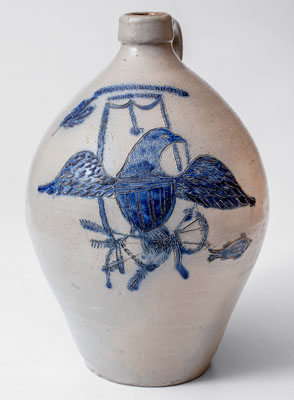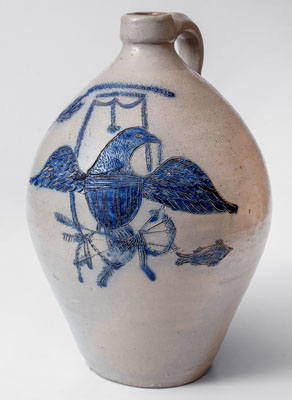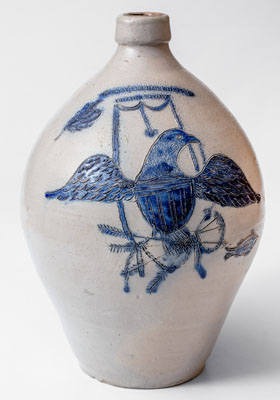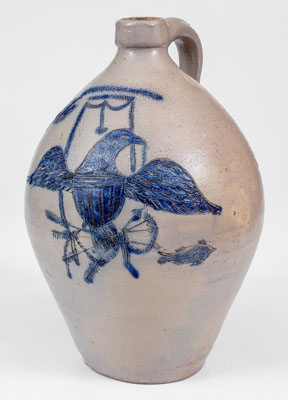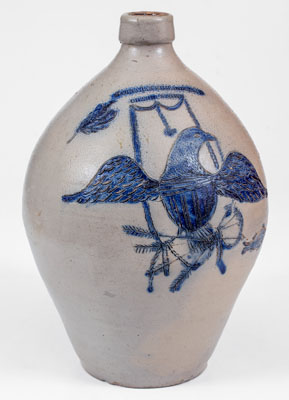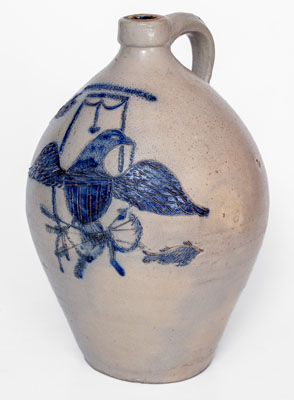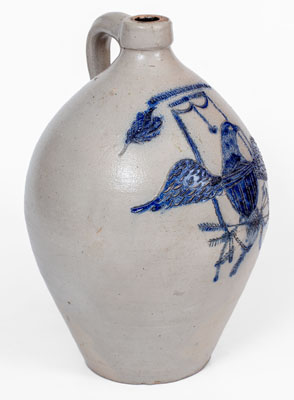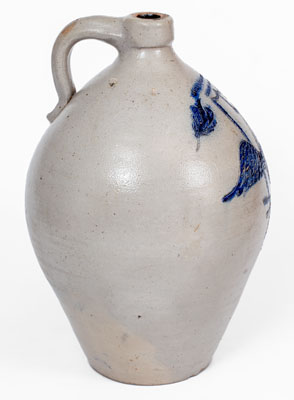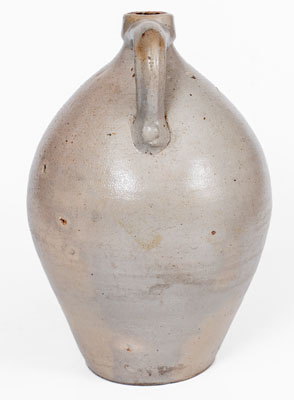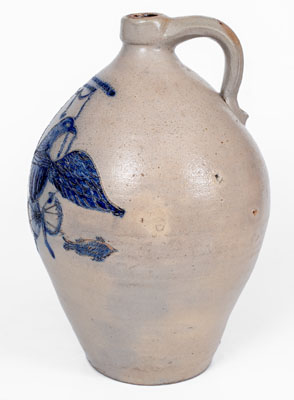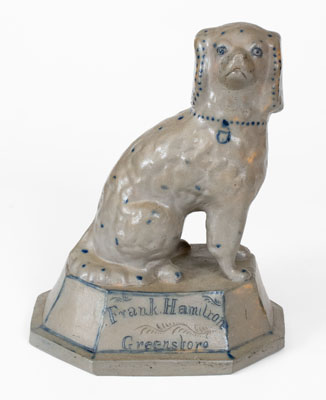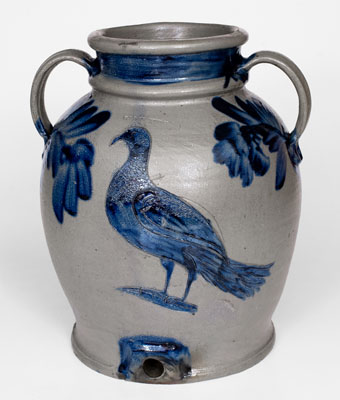Highly Important Two-Gallon Stoneware Jug with Incised Eagle and Fish Decorations, Stamped "BARNABAS EDMANDS & CO. / CHARLESTOWN," MA origin, circa 1830, highly-ovoid jug with semi-squared spout, decorated with a large incised design of a Federal eagle with spread wings and shield across its chest, clutching four arrows in one foot and carrying a rope, descending from its beak and held in a draped fashion from both feet. A heavily-scaled fish appears to the right. Deep, scalloped strokes of incising form the eagle's wing feathers while delicate dashed incising, created with a thinner stylus, delineate the finer feathering on its head and neck. A tasseled drape motif, underscoring the word, "CHARLESTOWN," in the maker's mark, descends behind the eagle and a heavily-incised floral motif decorates the jug's shoulder. Bold cobalt slip fills the incised designs and maker's mark. Among the finest examples of eagle decoration that we have ever offered, this Massachusetts masterpiece features an unusually large, detailed, and vividly-colored rendering of this iconic American image. The contrast between the cobalt slip and light gray background create a dramatic image. The decorative appeal and rarity of the decoration define this jug as one of the two finest examples of utilitarian pottery, either stoneware or redware, produced within the Boston neighborhood of Charlestown. (The other leading Charlestown product, the "Elisabeth Tarbell / 1806" stoneware jar by Frederick Carpenter, was sold in Crocker Farm's Spring 2021 auction, lot 1.) Rich in a ceramic legacy beginning with redware production in the early 18th century, Charlestown became a major manufacturer of stoneware at the turn of the 19th century with the work of Frederick Carpenter, who used a "BOSTON" stamp to identify his ware. In 1812, he became the master potter at the Austin Street shop of Barnabas Edmands, whose maker's mark appears on this jug. Edmands was not a potter, but rather a brass founder who became a pottery owner, hiring and even partnering with Carpenter until the latter's death in 1827. According to Lura Woodside Watkins' book, Early New England Potters and Their Wares, Edmands hired out a new lead potter, Charles Collier, upon Carpenter's death. Collier worked at the pottery for decades, and his abilities are evidenced by awards won in local 1839 and 1841 fairs for oversized stoneware vessels that he made, including a fifteen-gallon pitcher. Given his deep involvement with the pottery and years active, he possibly also created this eagle jug. Edmands and his descendants would be a dominant force in regional stoneware production for nearly one-hundred years, serving as Charlestown's sole producer of stoneware until 1905. According to Lorraine German's Ceramics in America 2019 article, "The Picture of the Old Pottery," Edmands's son, Benjamin B. Edmands, would became a potter himself, working at the family concern until the Civil War, when he served as lieutenant in the 54th Massachusetts Volunteer Infantry, one of the Union's first all-black regiments, famously depicted in the Academy-award-winning movie, Glory. An attributed Edmands Pottery jar of similar age to this jug, depicting a molded Federal eagle and date of the Battle of Bunker Hill on reverse, is on display at the William C. and Susan S. Mariner Southern Ceramics Gallery at the Museum of Early Southern Decorative Arts, a further exhibition of patriotic expression in this pottery's work. The jug to be auctioned was previously owned by noted ceramics author and collector, Georgeanna Greer, and made an icon in its field for its placement on the covers of the first and second editions of her well-known 1981 book, American Stonewares: The Art & Craft of Utilitarian Potters. Further illustrated and discussed on p. 34, Greer describes the jug with the following: "A 1 1/2 gallon jug of ovoid form. It has a pale gray salt-glazed exterior and brown slip glazed interior. A large eagle with spread wings and sheaf of arrows in his claw sits upon a rope swing. All is incised with considerable detail and colored with cobalt blue." With a design that speaks for itself and a connection to one of Massachusetts's founding families of stoneware production, this work is among the finest examples of Northeastern United States to come to auction in years. Few American stoneware objects of this decorative quality remain outside of museum collections. Literature: Illustrated in Greer, American Stonewares: The Art & Craft of Utilitarian Potters, cover and p. 34. Provenance: Georgeanna H. Greer Collection; Harmer Rooke Galleries Auction of the Georgeanna H. Greer Collection, November 18, 1992. Strong overall condition. An approximately 7 1/2" thin spider line to proper right side of jug, not affecting decoration. A 1 3/4" line at base on front, forming an approximately 3" x 2 1/4" Y-shaped line on underside. Some wear to incising. The following minor flaws: a 7/8" line in spout; two short vertical lines at base and a short line to underside, all possibly in-the-firing; two small, glazed-over base chips; tight lines at the juncture of the jug's handle with the body of the jug; a very faint 3" vertical line to reverse; and small in-the-firing iron pings to surface. H 14 1/2".

